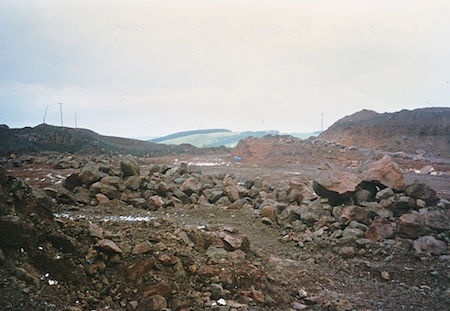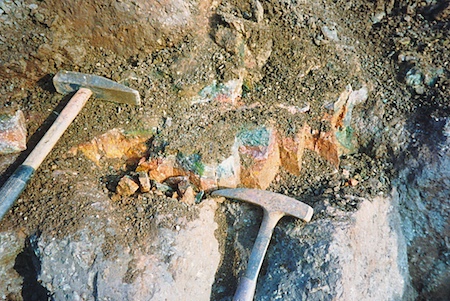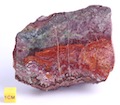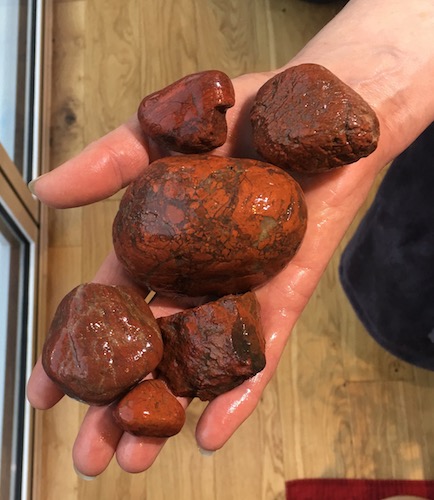
 |
| Scottish Jasper |
Jasper is a silica microcrystalline Quartz rock that, unlike agate, is composed of 5 to 25% Iron. This makes it an opaque material and the colour can be red, yellow, green, brown, black or rarely blue. Some jaspers are banded like agate but these bands are opaque. The commonest colour is red due to the iron inclusions. Jasper can exhibit conchoidal fracture and can take a high gloss polish similar to agate. A green variety with red spots is known as Bloodstone and examples of this can be found here in Scotland. In the Victorian era jasper from Scotland was used extensively in Scottish Pebble Jewellery particularly the red and yellow varieties found in the Campsie Hills north of Glasgow. Because it forms in a variety of different rock types it is found extensively over a number of localities here in Scotland. Large amorphous masses of jasper are a common finding in ploughed fields, some exhibiting a beautiful deep red colour. The term “Jasp-agate” that crops up from time to time and this seems to refer to jasper with banding or where there is a combination of both agate and jasper. The material from Burn Anne near Galston is often referred to as a “Jasp-agate” but I feel that specimens from here are not true jasper but are entirely agate. Different varieties of jasper can also be described by their patterning and colour but this is mainly in relation to the Lapidary industry and I will not describe that further here. |
| Localities in Scotland |
As I indicated above masses of jasper, some quite large, is quite a common find in fields and streams in certain areas of Scotland. The colour of this material is predominantly red but yellow is also another common color. The most well known localities though are in the Campsie Hills north of Glasgow. This material was extensively used in Scottish Pebble Jewellery in the 19th century but nice material can also be found today........by careful searching! |
 |
| The Campsie Hills from near Strathblane, north of Glasgow. |
| Jasper finds "in the field" in the Campsie Hills, north of Glasgow |
 |
 |
 |
 |
 |
The Birrenswark Carboniferous Olivine-Basalt lava series in the South of Scotland extend eastwards to Langholm and westward to the Solway coast near Kirkbean. The lava gives rise to a low range of hills 2-3 miles northwest of Ecclefechan. Around this area the lavas are well exposed in a north-facing escarpment and in the striking mesa-like hill of Birrenswark. Serendipity can often help and in 1993 when the nearby M74 road link between England and Scotland was being upgraded a temporary quarry was opened near Cowdens Farm about 2 miles northwest of Ecclefechan. I was lucky enough to hear about this quarry, which worked the Birrenswark lavas series, and managed to visit 2-3 times and collects some fantastic specimens of vein jasper before it was closed and landscaped back into farmland. The jasper from this locality is bright red and yellow and some specimens had associated Malachite and even fine native Copper wires in small cavities. Agate and smoky Quartz geodes could also be found in the quarry. As these lavas outcrop at a number of localities specimens can be found in some of the burns around Ecclefechan, farmland near Carrutherstown near Annan, near Kirkbean on the Solway coast and loose water-worn blocks can be found on the beach shingle of Rascarrel Bay near Auchencairn. |
 |
 |
| Cowdens temporary Quarry, near Ecclefechan, January 1993 | 4 inch thick vein of Jasper in Cowdens Quarry, 1993 |
 |
 |
 |
 |
 |
 |
| Rascarrel Bay on the Solway coast near Auchencairn | A Jasper nodule from the beach shingle Rascarrel Bay |
As stated above jasper is a common find in ploughed fields around Scotland. Where the original source of a lot of this material was is unknown but it tends to be commoner in areas where agates are also found. Most of this “drift” jasper is an intense red colour but yellows, browns and even blue jasper can be found. |
 |
| Loose blocks or water worn pebbles of Jasper collected in a short space of time in a field near Dunure, Ayrshire. The original source od this material is unknown? |
Of the other areas in Scotland where jasper has been found some were only temporary and the same area now shows no evidence of anything. There are many reasons for this including quarries being opened for building material in the Victorian era that have long since been built over or landscaped. Areas where it was found but that are now “off limits” such as Arthurs Seat and Blackford Hill in Edinburgh. Craiglockart Quarry in Edinburgh was also one such place where it is impossible to find much there now but some beautiful jasper has been found in the past. The Scottish borders north of the Cheviot Hill is also a well-known area for jasper. It can be found near Jedburgh, south of Hawick, near Oxenham, Bowmont Water and around Crawford and Biggar in Lanarkshire. Here is a selection of a few other areas where some nice Jasper has been found |
 |
 |
 |
 |
Just about everywhere in Scotland now there are windmills being put up. As well as foundations for the windmills themselves they are putting in hundreds of miles of new tracks across field, valleys and high hills, often despite local opposition!
|
 |
| < Home |